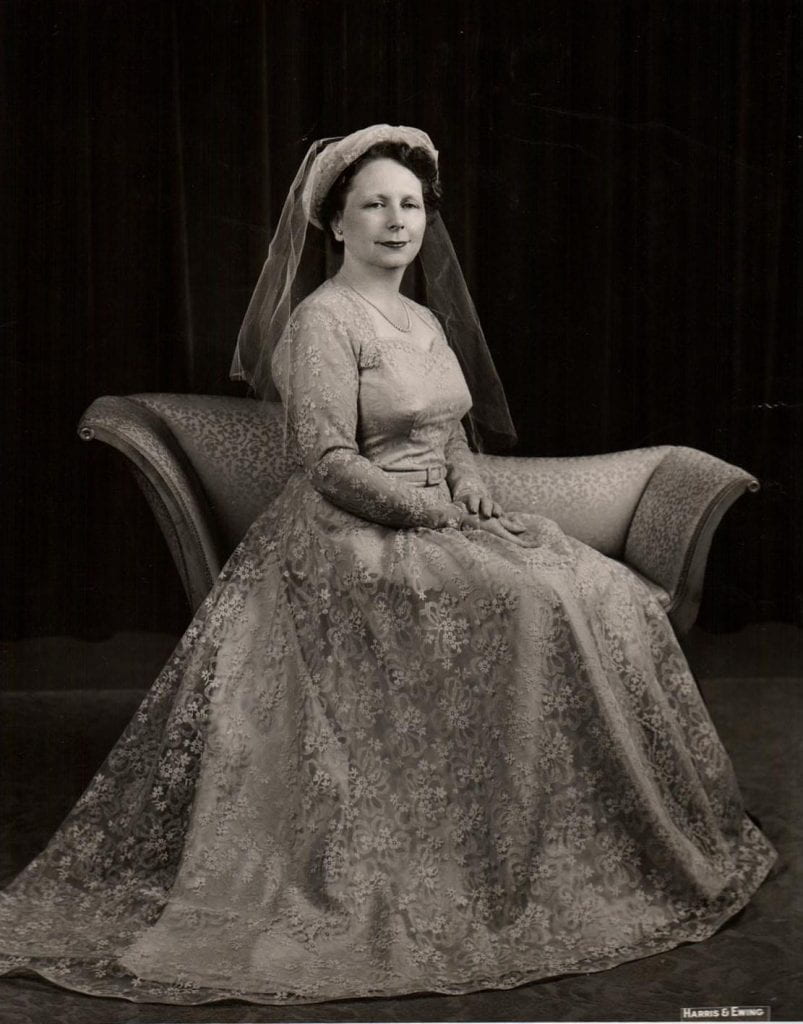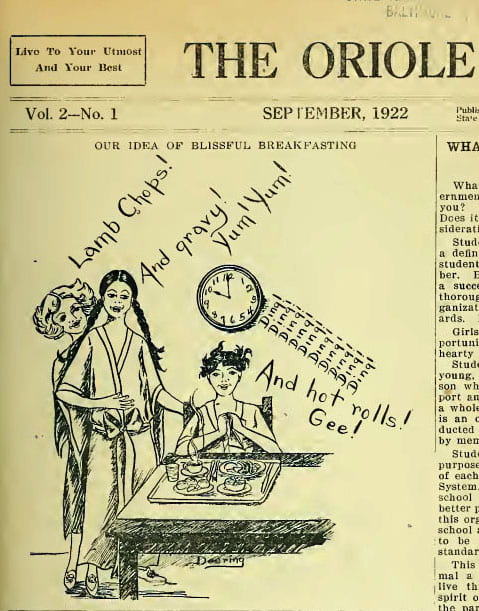As we celebrate the anniversaries of both the founding of Towson University in 1866, and its move to this campus in 1915, the Towson University Archives and Special Collections department is taking time to look back over the school’s history and some of the important but lesser-known people who have influenced it.
This is one of my very favorite comics from our student newspapers.
I love the messy hair, the fastidiously drawn bow on the dressing gown, the detail of the food on the tray, and the joy of lamb chops and gravy for a late breakfast at 10am.
It was drawn by Anna Virginia Doering, a graduate of the Class of 1923. She drew comics for the new student newspaper, then known as The Oriole, celebrating those moments almost all students at the Maryland State Normal School [MSNS] would share: anxiety surrounding exams, pride in their chosen profession of teaching, and the excitement of living away from home for the first time, which included dining at school.
At that time, the cafeteria was actually in the Administration Building, now known as Stephens Hall and served faculty, commuters, dormitory residents, and children from the campus elementary school.

For the first 10 years of its existence at MSNS, that one dining hall was sufficient to serve all — enrollment didn’t exceed 500 teaching students until 1922, and by that point, signs pointed to the need for a new dining space.
By 1926, a new wing had been added on to the Newell Dormitory and a dining room that could seat over 500 people was completed.
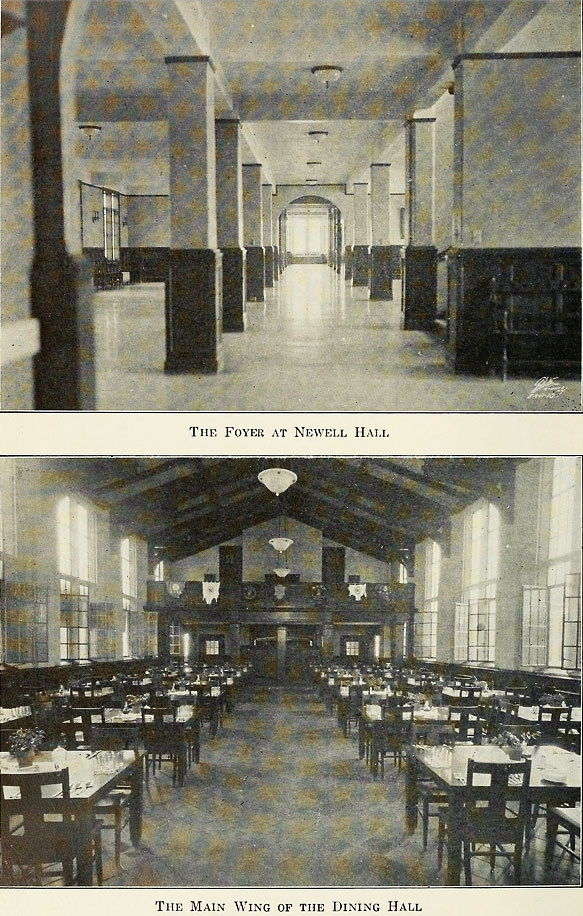
“Self service for breakfast and lunch will be continued,” reported The Oriole in October of 1925. “But the whole dormitory family will come together for dinner, which will be served in the evening. Small tables, seating four and eight, will replace the long refectory tables now in use in the dining room. The cafeteria in the Administration Building will be maintained for the non-resident students of the Normal School who eat lunch in the building, and for the children of the Elementary School.”
This cafeteria in the Administration Building seems to have disappeared not long after the introduction of the dining room in Newell.
Much of the food offered in the dining halls came from farms on the property of MSNS. This is a copy of a report made by the school farmer in which he lists crops sent to the kitchen.

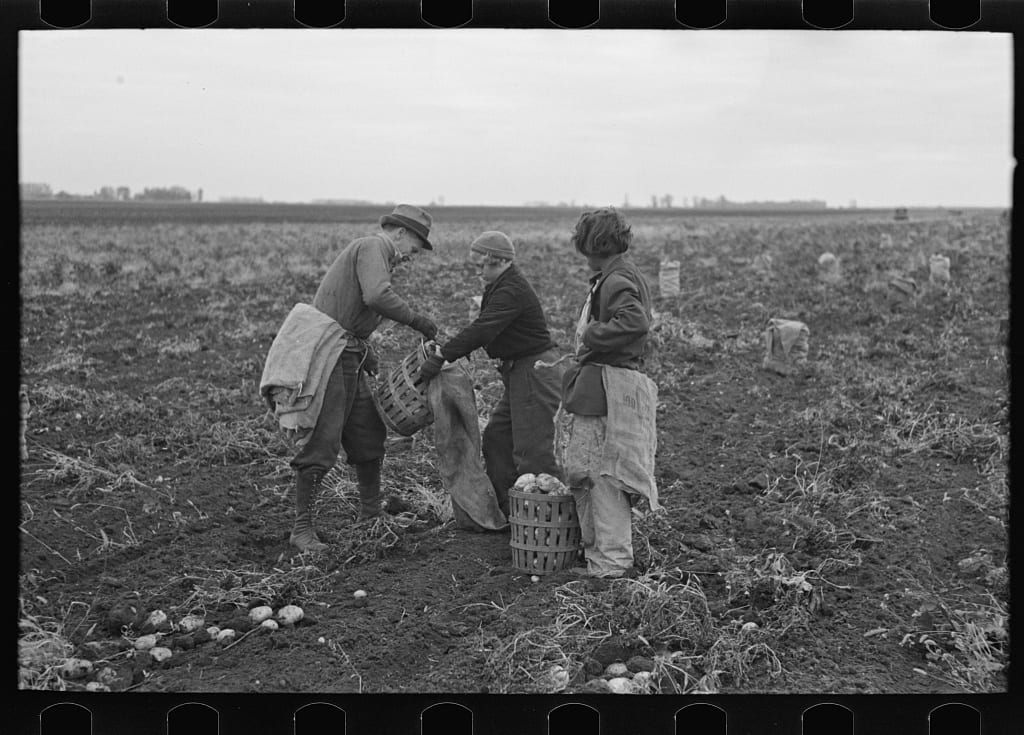
Here is a photo from the Library of Congress from 1937 —
these folks are using bushel baskets to harvest potatoes.
Each basket earned them three cents.
The farms on campus lasted at least through the 1950s as the last of them were bulldozed to make way for the second Lida Lee Tall building in 1960.
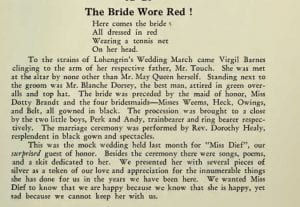
The farmer would have delivered his produce to the kitchen staff which was headed by a dietitian starting in 1921. This addition to the MSNS staff was made after a survey by a member of Columbia University’s Household Economics Department. At first, this position was filled every few years. By 1930, however, it became a more stable position. Mary Elizabeth Diefenderfer served not only as Dietitian but also as Director of Dormitories from 1930 until her marriage in 1938. She was replaced by Juanita Greer — more about her in a bit. During this time frame, the person who served
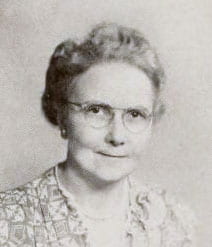
longest in the position of Dietitian was Elsie Pancoast Wasson, who was at Towson from 1947 until 1961.
By 1969, the title of Dietitian would change to “Food Services Manager” and later “Food Services Administrator”.
As reported in “Seventy-Five Years of Teacher Education”, after World War I, the biggest problem the dining hall faced was the need for good kitchen help. At first, the school employed men who had worked in kitchens during the war, but one gathers that their return to the civilian world met a few bumps along the way: “These were experiences which could not possibly act as apprenticeship for the life of a dormitory.” A change was made to hire African American help, and most of the photos we have of the kitchen staff show that they are made up of men, and later, women of color.
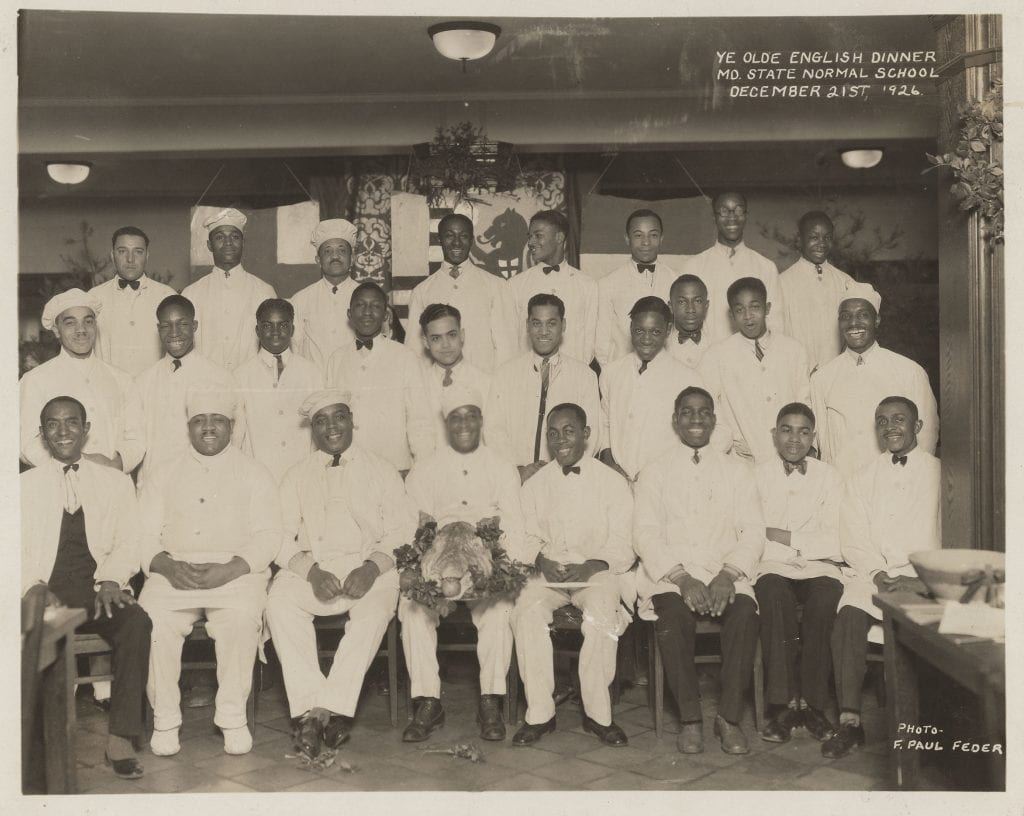
Sadly, we don’t know the names of most of these gentlemen.
Besides enjoying dinner served at the table, a student club named the Chimes Guild, rang chimes and sang grace before breakfast and dinner every day starting sometime in the 1930s. Using chimes to announce meals was apparently something done in the military and on trains and I’m sure in lots of other institutions. The only chimes I can remember ever hearing was the old NBC radio cue. I imagine the chimes sounded something like this:
The practice of using the chimes and singing grace continued, until the 1950s, when dinner was no longer served at the table but offered, like lunch and dinner, as a cafeteria-style service.
With the addition of the Junior College in 1947, and therefore an increase in commuter students, a dining hall with set dining hours was no longer the best option for everyone on campus. A year later, the school responded to wishes of the student body and opened a “milk bar” in the Administration Building. In April of 1948, The Towerlight reported “Plans for the milk bar were begun last October when the students requested a room where both men and women students could get together to eat, smoke, and talk. Milk, coffee, and tea will be sold and there is a possibility that doughnuts and buns will be available.” Even in this early article, however, there are foreseeable problems with this new enterprise. “Students are requested to keep the room clean by returning ‘coke’ bottles to the racks and cleaning the tables before leaving. The committee also suggests that the students realize that 600 people will have the responsibility of sharing the room.”
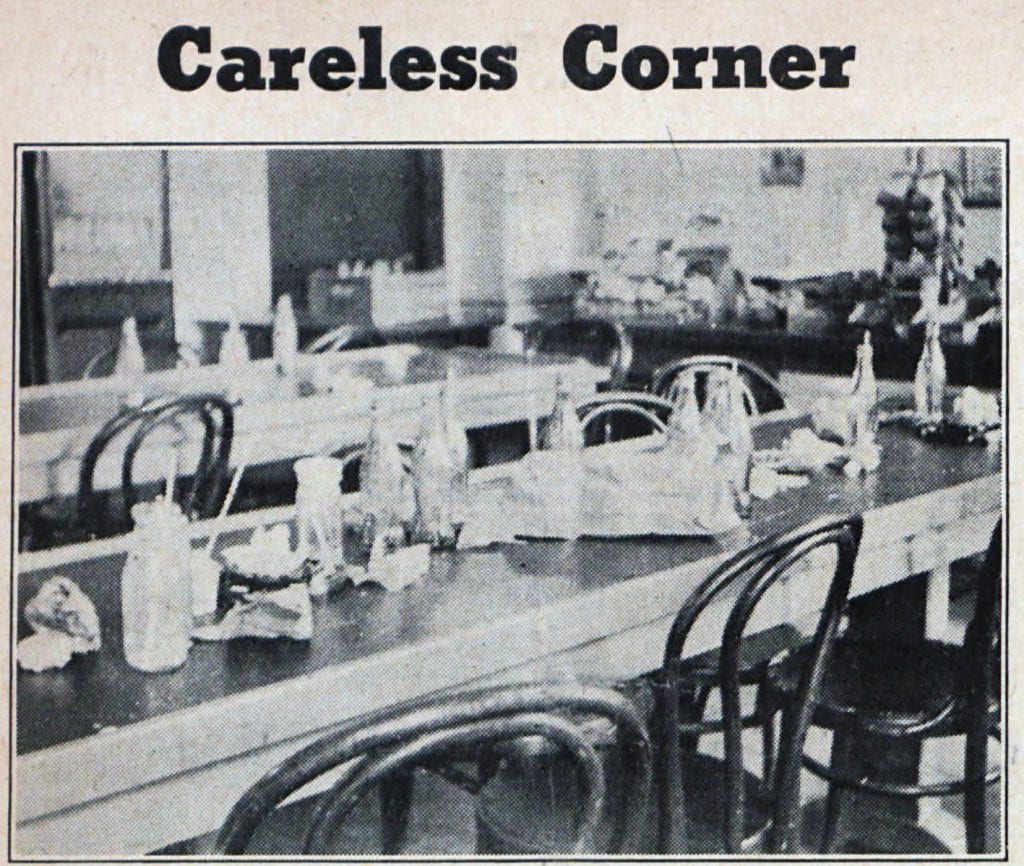
There was a contest to name the milk bar, and so by June of that year it was called “Co-Ed’s Corner”.
Within the first year of its existence, the problem of so many people sharing such a space was evident. The Towerlight publishing accounts of trashed tables and a smoke-filled room — smoking was allowed on campus and in buildings through the 1970s. The school saved money by not having staff bus the tables, but that didn’t mean that the community was always thoughtful about cleaning up after itself. The Student Government Association took up the charge and divvied up responsibility for clean-up among the classes.
Ultimately, the problem of space overtook both the Co-Ed Corner and the Bookshop and it was decided to move them to the ground floor of Newell Hall. At this point, Co-Ed Corner was renamed the Snack Bar and fell under the care of the Bookshop.
As the school population grew, the quality of the food served by the dining hall also came under fire. Part of this problem might have been the amount of money collected by the school for room and board. For 24 years, from 1933 to 1957, the school charged $216 a year from each resident student. $216 in 1933 could buy you what typically $3000 buys you today. By 1957, that same $216 could buy you only about $1800 worth of goods. So students were essentially spending less on room and board while at the same time the number of students had increased. This may have effected the quality of the food being offered in the dining hall. By April of 1952, a Dormitory Food Improvement Committee was formed to address improving the offerings at the dining hall.
By 1952, the crowded conditions led to a decision to renovate and expand the bottom portion of the Newell Hall dining wing.
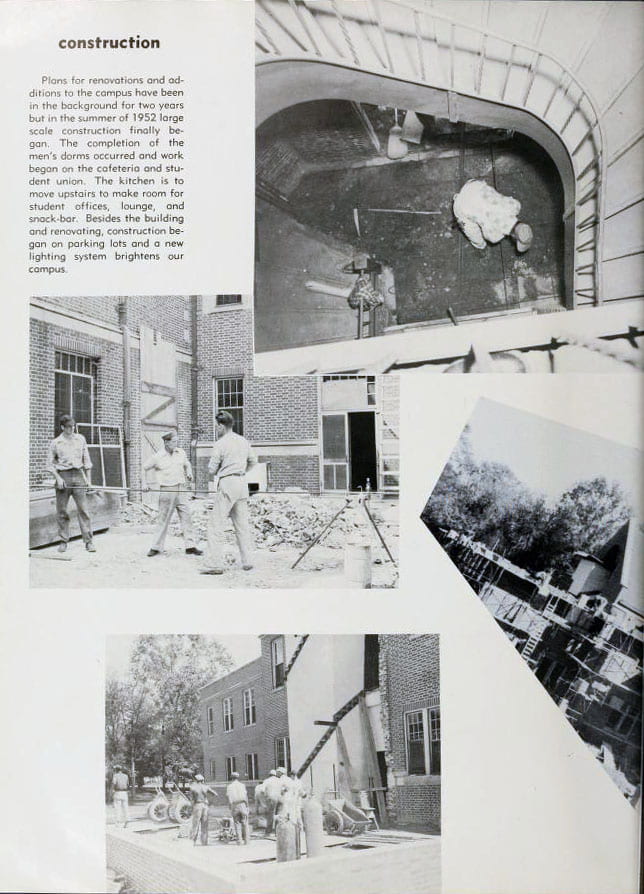
the renovation of Newell . . .
The kitchen would move upstairs (previously a dumb-waiter had moved food upstairs), and receive new equipment.
“Plans also include the construction of a student center in the basement of the present dining hall,” reported The Towerlight on April 18, 1952. “The main wing will house a large lounge with the two smaller wings having a soda fountain and student offices, respectively. There is also the possibility of including recreation, or play rooms, in the center.”
The new Student Centre opened in 1954.
The hours of the Snack Bar were also later — it opened from 8:30am to 10:30pm Monday through Thursday as well as 4:30 to 10:30 on Sundays. This allowed students taking night classes as well as dormitory students to get snacks or study breaks during odd hours.
The Student Centre was a place where students could eat, have a soda, play cards, study, or just talk.
In the meantime, a dining room just for the use of faculty and student organizations was opened on the lower level as well.
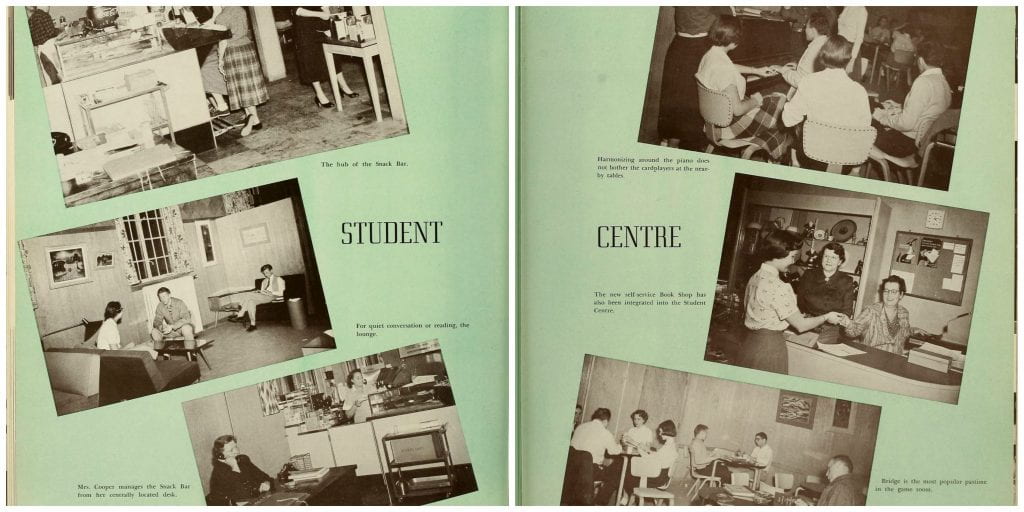
This might be a good time to talk about enrollment after World War II. This chart shows enrollment figures from 1915 when the Towson campus was established until 1972. As you can see, enrollment skyrocketed beginning in the early 1960s as Towson made the transformation from a teachers college to a comprehensive college.
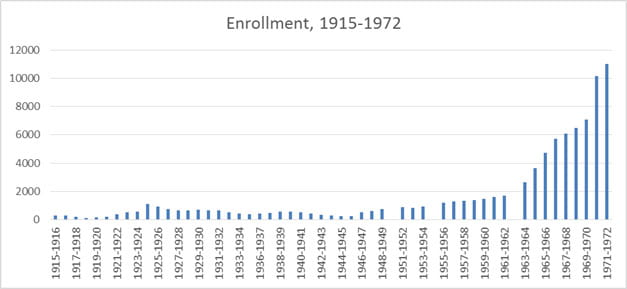
Ultimately, this explosion in enrollment meant that Newell Hall couldn’t serve everyone comfortably. As The Towerlight reported in November of 1963 “The cafeteria staff claims that [the wait in the dinner line] lasts for 13 1/2 minutes but individual students have timed themselves on several occasions and found this interval to be from 20 to 30 minutes.” It didn’t help that dinner was served only from 5:15 to 6:15.
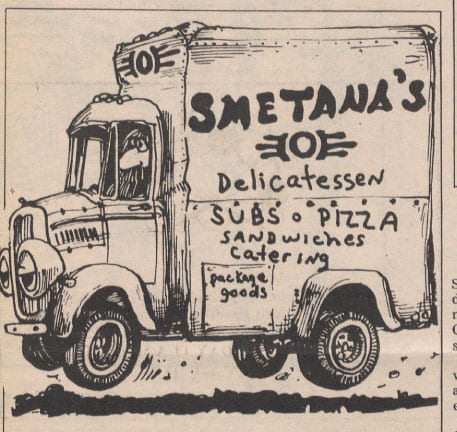 Meanwhile, the closest places to eat off campus were still a fair distance away. By the mid-1950s, you could walk down to York and Regester and get a sandwich at the Harry Little sub shop. It would take about another 10 years for a deli named Smetana’s to open closer to the school, near where the Starbucks on York Road now stands.
Meanwhile, the closest places to eat off campus were still a fair distance away. By the mid-1950s, you could walk down to York and Regester and get a sandwich at the Harry Little sub shop. It would take about another 10 years for a deli named Smetana’s to open closer to the school, near where the Starbucks on York Road now stands.
By 1965, a new dining hall was on the list of construction projects. There were hopes that a new one would be open within the year, but it would take 7 years for a new dining facility to finally open on campus.
In the meantime, complaints about the quality of food were mounting, as were complaints about long lines that often stretched outside the dining hall during poor weather.
Finally in February of 1972, the College Center, now known as the University Union, opened. It alleviated the demand for food with four dining areas, mostly serving lunch but eventually opening for breakfast and dinner. The Snack Bar also moved to the College Center. For the first time on campus, students had a variety of places to dine on campus.
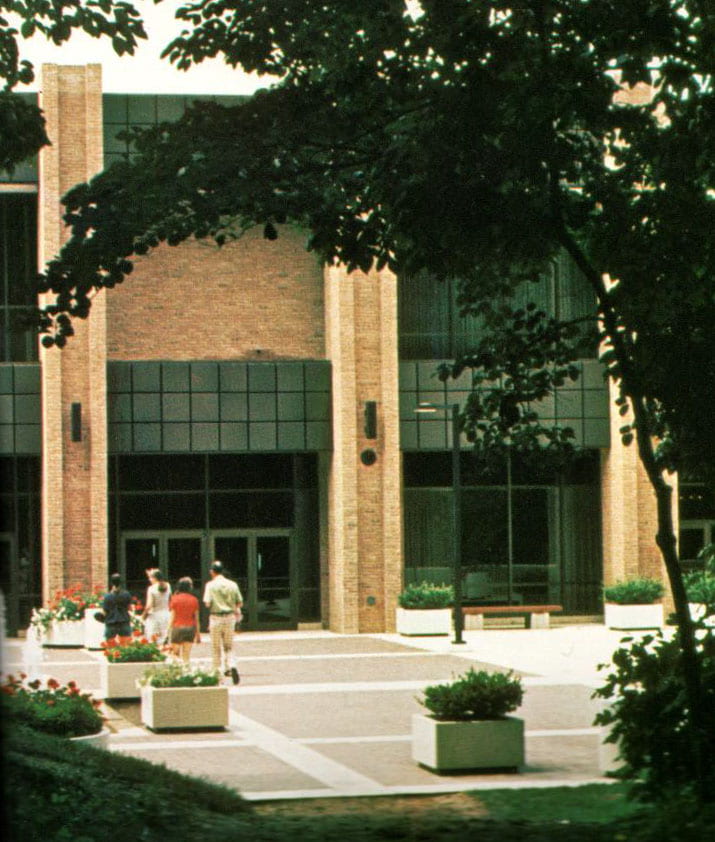
One last interesting bit of Towson trivia.
Remember how I said I’d talk more about Juanita Greer at the start of this post? She was Dietitian and Director of Dormitories from 1938 until 1942. She returned to campus in 1951 as the bride of President Hawkins.
